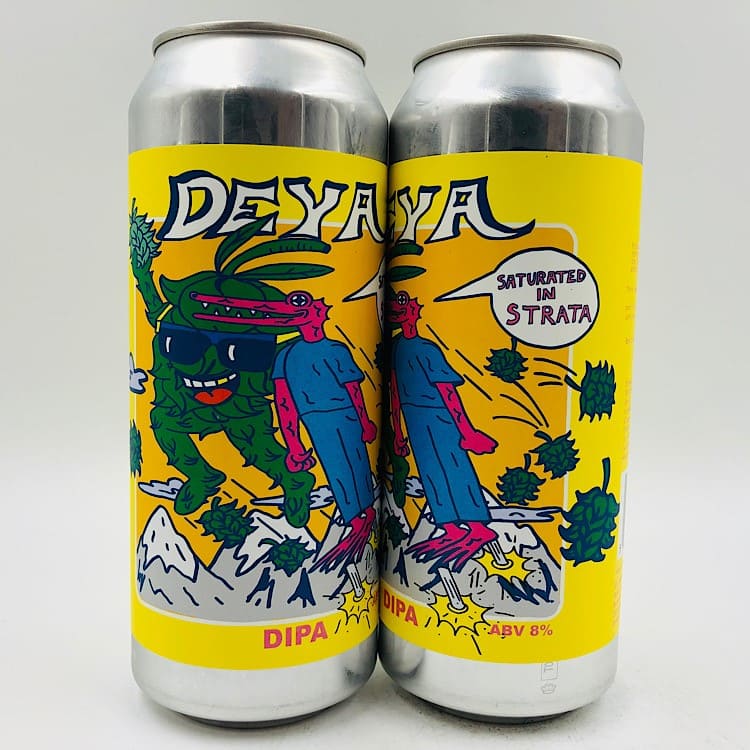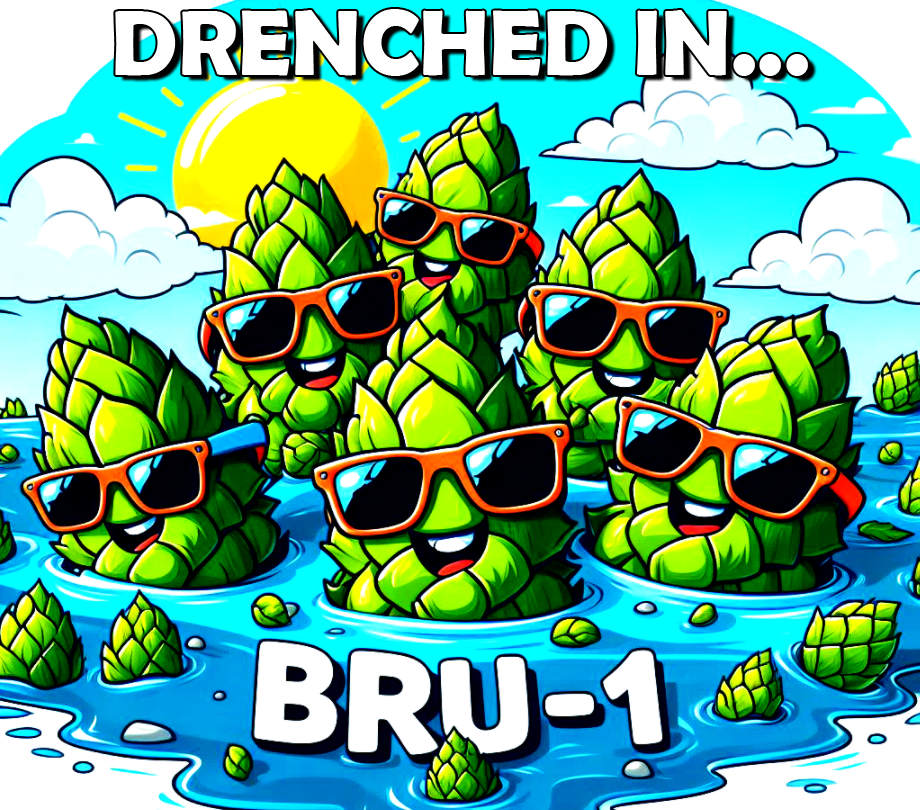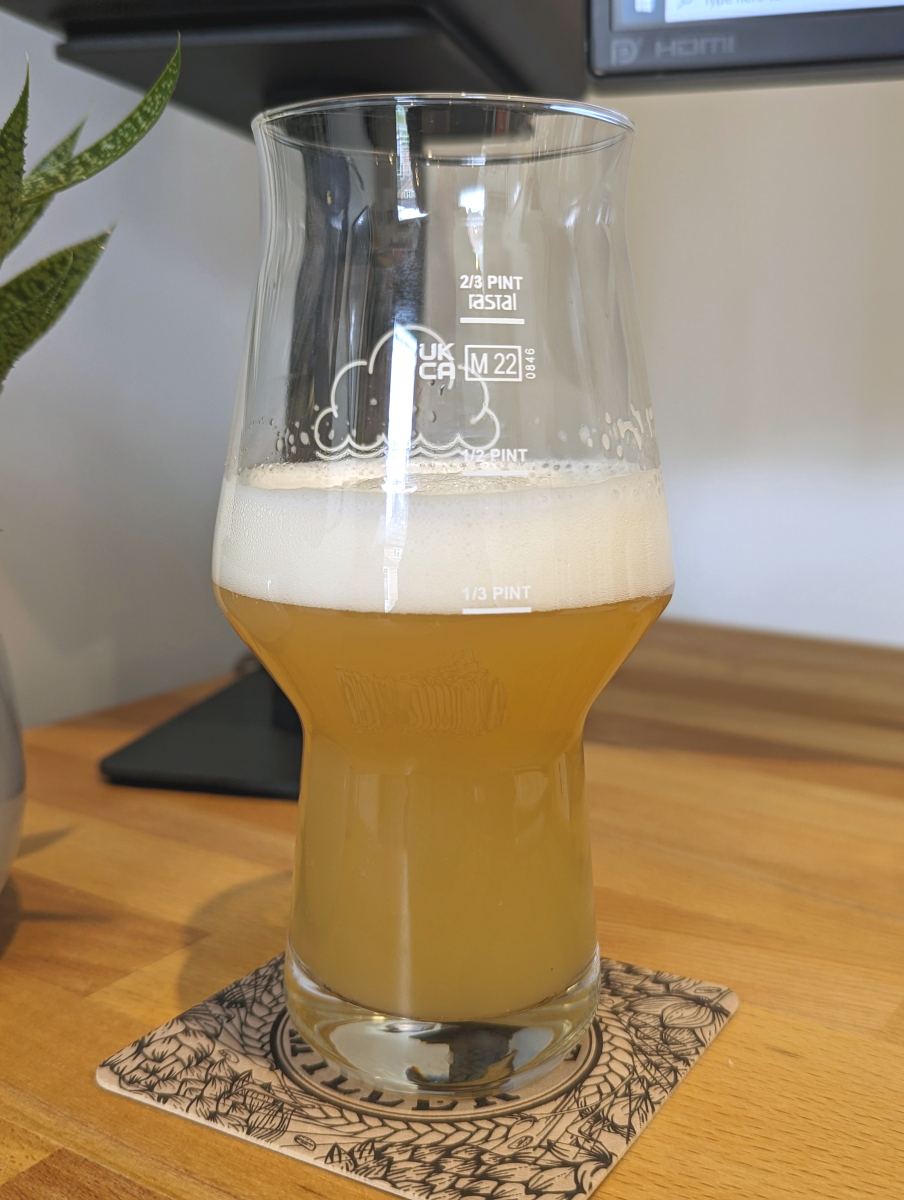- Recipe Type
- All Grain
- Yeast
- Lallemand Koln (2 Packs)
- Yeast Starter
- No
- Batch Size (Gallons)
- 6
- Original Gravity
- 1.073
- Final Gravity
- 1.018
- Boiling Time (Minutes)
- 30
- IBU
- 40
- Color
- 9 EBC
- Primary Fermentation (# of Days & Temp)
- 5 days @ 20°C, 2 days @ 21°C
- Tasting Notes
- Pineapple, Mango, Floral, Fruit Salad
I'm very fortunate to live within walking distance of DEYA Brewing, a truly fantastic independent brewery specialising in American-style IPAs and mixed-fermentation beers. Alongside the like of Verdant, they're renowned here in the UK as amongst the best purveyors of in particular Hazy/New England style pale ales and IPAs in the country, consistently banging out super juicy but endlessly crushable haze in the 6-8% ABV range that seems to (almost) always perfectly balance tropical fruit and rich mouthfeel with enough bitterness and structure to ensure things never come across as cloying or one-note.
Part of DEYA's annual rotation is a series called "Saturated In...", an 8% single-hop DIPA that works as a showcase of their favourite varietals in a given year. Over the last few years they've done versions for all the big hazy hops- Citra, Simcoe, Motueka, Mosaic, Nelson, Idaho 7, Galaxy, Amarillo- which have ranged from "excellent" to "outstanding"- the 2022 "Saturated in Strata" is the best single-hop beer I've ever drunk by a distance so big it's almost comical.

I've been tinkering and iterating with NEIPA recipes for probably three years now, and have finally found myself in a point where I'm happy with process and getting consistent results out of beers I brew. With this in mind, I set out to design a "framework" recipe similar to the Saturated In series that allows me to test single-hop varieties in a nicely repeatable, manner using a standardised grist, yeast and workflow. Because I'm deeply unimaginative, I decided to name this series "Drenched In...", mostly because the first iteration I tried was using Denali hops.
Having done a few of these now (Denali, Simcoe and most recent BRU-1), I'm at a point where I'm happy to share more widely the framework used here.
For the purposes of recipe writing, and for ungraciously abusing Microsoft Designer to create terrible images, I've used my recent BRU-1 variant, however as long as you follow the following basic principals you can rip out and replace with any hop you want to trial and should still get a pretty exciting result:
So, and with absolutely zero apologies for the carnal abuse of Microsoft's image generating AI, I bring you:

Vital Stats:
ABV: 7.2%
OG: 1.073
FG: 1.018
EBC: 9
IBU: 40
BU/GU: 0.55
Recipe as below for circa 23L/6 gallon fermenter volume. If you're using non Cryo hops, you might want to up to 25/6.5 to compensate for hopping related losses:
You may want to throw in a handful of rice hulls if you're prone to stuck sparges. This one drained a little slowly for me, but didn't stick (Brewzilla Gen 3.1 with the extended malt pipe and boiler).
I used a fairly simple "medium fermentability" mash regiment of:
Water profile is IMO a bit of a personal thing. I like about a 3:1 Chloride to Sulphate ratio in my NEIPAs. The profile I've got for this one lists 125ppm Calcium, 140ppm Chloride and 45ppm Sulphate, which is amusingly basically what I use for Old Ales and Winter Warmers. If you have a preferred NEIPA ratio, use that.
As with all my beers, modern 30 minute boil, none of this "faff around for an hour" stuff.
Hopping isn't too complex (single hop, duh), but as previously mentioned there's a LOT of it. BRU-1 shown here, but rip out and replace with whatever you want to use instead (once I can find somewhere supplying it, I intend to do a Cryo Strata version for 100% ridiculous passionfruit).
You want around 40-45 IBU in bitterness according to Brewfather to make this as I intend it. You'll get a lot of perceived bitterness from the dry hopping, so if you overdo it here then you'll probably have some astringency and lose the super juicy "candied fruit" effect this recipe is going for. My $0.02, at least- your mileage may vary so do feel free to adjust to suit your own tastes. The whirlpool is pretty sizeable here and is the biggest contributor to the IBUs, but that 10m addition is really important for getting some structure and backbone to the beer. This is a spot where process is important- I've long avoided using hops spiders in my system due to the effects on utilisation, but you really need to be pretty vigorous to try and get all that green matter to drop into a nice compact cone otherwise you'll dump a tonne of excess hop matter into your fermenter which is liable to mess things up.
Fermentation is pretty simple: 20°C for 5 days, then 21°C for 2 or as long as it takes for FG to stabilise. Two packs of Lallemand Koln dumped straight into the fermenter, no rehydration, no oxygenation. My process is to run the first few days with a standard airlock, then when I high krausen dry hop around 48 hours after the first signs of fermentation swap for a pressure setup set to around 2PSI.
At day 7, assuming FG has been hit, I soft crash down to 10°C or so and then dump trub. I've been using a Fermzilla with collection jar to achieve this. If you can't dump trub, you might want to go lower. There's a high chance of restarting fermentation with your second dry hop if you do it warmer. My process for the second DH is to remove the top gas port from my Fermzilla and drop the hops through there whilst purging the headspace with CO2. You could also use the classic "sous vide magnets and hop bags" or a hop bong setup, but be advised that you need a big bag for 150g hops if you want to get decent utilisation out of them and not just have a massive sticky clump.
I limit contact time with the second DH to 2 days before I package via kegging. You could probably go a bit longer, but I don't really feel the need to, a bit of hop burn is always going to mainifest here and the last thing I want to do is make it any worse.
Carb is around 2.4 volumes, and the beer needs at least 4-5 days and ideally about a week to lose any hop bite. The picture below is at 6 days, it's still got a gentle prickle of hop bite but nothing that affects drinkability. Super tight shaving foam head, nose full of juicy ripe pineapple, lovely velvety mouth feel, just enough bitterness to keep things balanced. I love it, and I hope you do too- a great way of testing out what New World hops bring to a party.

Now, what are you waiting for? Go drench yourself in something delicious!
Part of DEYA's annual rotation is a series called "Saturated In...", an 8% single-hop DIPA that works as a showcase of their favourite varietals in a given year. Over the last few years they've done versions for all the big hazy hops- Citra, Simcoe, Motueka, Mosaic, Nelson, Idaho 7, Galaxy, Amarillo- which have ranged from "excellent" to "outstanding"- the 2022 "Saturated in Strata" is the best single-hop beer I've ever drunk by a distance so big it's almost comical.

I've been tinkering and iterating with NEIPA recipes for probably three years now, and have finally found myself in a point where I'm happy with process and getting consistent results out of beers I brew. With this in mind, I set out to design a "framework" recipe similar to the Saturated In series that allows me to test single-hop varieties in a nicely repeatable, manner using a standardised grist, yeast and workflow. Because I'm deeply unimaginative, I decided to name this series "Drenched In...", mostly because the first iteration I tried was using Denali hops.
Having done a few of these now (Denali, Simcoe and most recent BRU-1), I'm at a point where I'm happy to share more widely the framework used here.
For the purposes of recipe writing, and for ungraciously abusing Microsoft Designer to create terrible images, I've used my recent BRU-1 variant, however as long as you follow the following basic principals you can rip out and replace with any hop you want to trial and should still get a pretty exciting result:
- Most of your IBUs will come from from the huge whirlpool, but you need a small bittering addition in the boil to round things out. I went with a few grams of BRU-1 at 10 minutes (in my case, 8.2g). You want to target 40-45 IBU indicated and a BU/GU of about 0.55-0.6. If you go lower, it will start to feel unbalanced. If you go higher, you'll lose some of the "juice bomb" effect as you'll get a LOT of perceived bitterness from the dry hopping.
- If you can, use Cryo/LupuLN2/LUPOMax hops. This recipe goes pretty big, at very nearly a full pound of 20% AA BRU-1 Cryo in total. Hopping rates are circa 7g/L whirlpool, and about 11g/L dry hop, so you will have a lot of hop matter to contend with. You'll need to approximately double these rates with T90 hops and I can't envision dealing with a 22g/L dry hop in a 23 gallon batch being much fun for anyone.
- This recipe as written uses a double dry hop, once at high krausen and once at end of fermentation, so you really need to have systems and processes in place to be able to both dry hop with zero oxygen exposure, and to be able to either dump trub, crash to 10°C or below, or ideally both. If you do your second DH warm without dumping trub, chances are you will restart fermentation and probably end up with a diac-filled mess unless you want to ride out your second DH for 5 days instead of 2, for all the additional risk of green/grassy flavour and hop burn that will bring. You could move to a single DH, but I think part of the fun of this one is pairing your single hop of choice with a yeast that produces significant amounts of beta-glucosidase, and the added complexity that possible biotransformation can bring.
- The FG is high for a reason. Please don't end up sticking to the absolute rubbish that is the BJCP guidelines for hazies, and either mashing cooler or using a higher attenuating yeast to get it down to 1.010-1.015. 1.018-1.019 is absolutely where this should be, and honestly if you like your NEIPAs super creamy you could probably go into the low 20s. If you're over-attenuating, you can add a bit of maltodextrin either in the boil or post fermentation if you can do so in a zero oxygen manner. I've had to do that once so far and whilst not quite as good as versions that finish out at the right FG, it's 99.9% of the way there.
So, and with absolutely zero apologies for the carnal abuse of Microsoft's image generating AI, I bring you:

Vital Stats:
ABV: 7.2%
OG: 1.073
FG: 1.018
EBC: 9
IBU: 40
BU/GU: 0.55
Recipe as below for circa 23L/6 gallon fermenter volume. If you're using non Cryo hops, you might want to up to 25/6.5 to compensate for hopping related losses:
| Malt | Weight | Percentage |
| Golden Promise (Crisp) | 5.27 KG | 73% |
| Wheat Malt (Crisp) | 0.722 KG | 10% |
| Golden Naked Oats (Simpsons) | 0.505 KG | 7% |
| Flaked Oats (Simpsons) | 0.361 KG | 5% |
| Torrified Wheat (Thomas Fawcett) | 0.361 KG | 5% |
You may want to throw in a handful of rice hulls if you're prone to stuck sparges. This one drained a little slowly for me, but didn't stick (Brewzilla Gen 3.1 with the extended malt pipe and boiler).
I used a fairly simple "medium fermentability" mash regiment of:
- 68°C for 45 minutes
- 75°C for 15 minute (mash out)
Water profile is IMO a bit of a personal thing. I like about a 3:1 Chloride to Sulphate ratio in my NEIPAs. The profile I've got for this one lists 125ppm Calcium, 140ppm Chloride and 45ppm Sulphate, which is amusingly basically what I use for Old Ales and Winter Warmers. If you have a preferred NEIPA ratio, use that.
As with all my beers, modern 30 minute boil, none of this "faff around for an hour" stuff.
Hopping isn't too complex (single hop, duh), but as previously mentioned there's a LOT of it. BRU-1 shown here, but rip out and replace with whatever you want to use instead (once I can find somewhere supplying it, I intend to do a Cryo Strata version for 100% ridiculous passionfruit).
| Hops | Type | AA | Weight | IBU | Timing | Process |
| BRU-1 | LUPOMax | 20.0% | 8.2g | 6.4 | 10m | Boil |
| BRU-1 | LUPOMax | 20.0% | 160g | 33.6 | 30m | Whirlpool @ 75°C |
| BRU-1 | LUPOMax | 20.0% | 100g | N/A | 2 days (High Krausen) | Dry Hop |
| BRU-1 | LUPOMax | 20.0% | 150g | N/A | 7 days (Fermentation Complete) | Dry Hop |
You want around 40-45 IBU in bitterness according to Brewfather to make this as I intend it. You'll get a lot of perceived bitterness from the dry hopping, so if you overdo it here then you'll probably have some astringency and lose the super juicy "candied fruit" effect this recipe is going for. My $0.02, at least- your mileage may vary so do feel free to adjust to suit your own tastes. The whirlpool is pretty sizeable here and is the biggest contributor to the IBUs, but that 10m addition is really important for getting some structure and backbone to the beer. This is a spot where process is important- I've long avoided using hops spiders in my system due to the effects on utilisation, but you really need to be pretty vigorous to try and get all that green matter to drop into a nice compact cone otherwise you'll dump a tonne of excess hop matter into your fermenter which is liable to mess things up.
Fermentation is pretty simple: 20°C for 5 days, then 21°C for 2 or as long as it takes for FG to stabilise. Two packs of Lallemand Koln dumped straight into the fermenter, no rehydration, no oxygenation. My process is to run the first few days with a standard airlock, then when I high krausen dry hop around 48 hours after the first signs of fermentation swap for a pressure setup set to around 2PSI.
At day 7, assuming FG has been hit, I soft crash down to 10°C or so and then dump trub. I've been using a Fermzilla with collection jar to achieve this. If you can't dump trub, you might want to go lower. There's a high chance of restarting fermentation with your second dry hop if you do it warmer. My process for the second DH is to remove the top gas port from my Fermzilla and drop the hops through there whilst purging the headspace with CO2. You could also use the classic "sous vide magnets and hop bags" or a hop bong setup, but be advised that you need a big bag for 150g hops if you want to get decent utilisation out of them and not just have a massive sticky clump.
I limit contact time with the second DH to 2 days before I package via kegging. You could probably go a bit longer, but I don't really feel the need to, a bit of hop burn is always going to mainifest here and the last thing I want to do is make it any worse.
Carb is around 2.4 volumes, and the beer needs at least 4-5 days and ideally about a week to lose any hop bite. The picture below is at 6 days, it's still got a gentle prickle of hop bite but nothing that affects drinkability. Super tight shaving foam head, nose full of juicy ripe pineapple, lovely velvety mouth feel, just enough bitterness to keep things balanced. I love it, and I hope you do too- a great way of testing out what New World hops bring to a party.

Now, what are you waiting for? Go drench yourself in something delicious!


